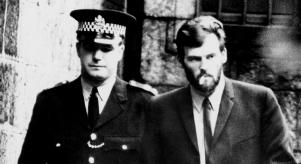
Derek Bentley: The teenager wrongly hanged for murder
My Death is a Mockery is a 1952 film directed by Tony Young and featuring Donald Houston, Kathleen Byron, and Bill Kerr. The plot revolves around a fatal police shooting during a confrontation, leading to the hanging of the protagonist. On the afternoon of 2nd November 1952, 16-year-old Christopher Craig brought his girlfriend to watch the movie in Croydon, England.
Later that evening, Craig, armed with a knuckleduster, a sheath knife, and a sawn-off Colt .45 revolver, planned to rob a butcher's shop. Despite his young age, Craig possessed 40 guns and aspired to become a gunsmith. While on the street that night, he encountered his accomplice, 19-year-old Derek Bentley, with whom he had already committed a series of minor burglaries.
Bentley had faced health challenges from a young age, including a broken nose and recurrent seizures. At 16, he was sent to Kingswood Training School, where he was described as a cheerful and friendly teenager functioning at the level of a ‘feeble-minded 11-year-old.’ Bentley had experienced the loss of several close relatives during the Blitz and had been epileptic since the age of five.
That evening, when Bentley joined forces with Craig, he had equipped himself with a small knife. The pair boarded a bus bound for Croydon town centre, where Craig handed Bentley his knuckleduster.
Disembarking at West Croydon Station, they walked a short distance to Tamworth Road, focusing their attention on the wholesale confectionary warehouse of Barlow and Parker.
Scaling the six-foot iron gates, they made their way onto the property. Simultaneously, Edith Ware, in the midst of putting her daughter to bed, glanced out the window and observed Craig and Bentley ascending the gates. Alarmed, she quickly contacted the police to report the unfolding scene, prompting the dispatch of two police cars to the location.
Detective Constable Frederick Fairfax was in one car, accompanied by other officers, while the other car carried Police Constable Sidney Miles.
Upon reaching the scene, Craig and Bentley had positioned themselves on the roof of the building. Det-Con Fairfax ascended the roof via a drainpipe, identifying himself as a police officer. He directed Craig and Bentley, who were hiding behind a lift stack, to come out. In response, one of them challenged Det-Con, stating that if he wanted them, he would have to come and get them. Det-Con Fairfax rushed to the lift stack, successfully seizing Bentley and attempting to pull him to apprehend Craig as well.
As Det-Con confronted Craig, his grip on Bentley slipped away. Later, Det-Con Fairfax recounted hearing Bentley exclaim, ‘Let them have it, Chris!’ Another officer, Police Constable Harrison, had ascended to an adjacent building by this point and also heard Bentley utter the same command. Suddenly, there was a blinding flash, followed by an intense pain in Det-Con Fairfax's shoulder. A bullet had entered his right shoulder, causing him to fall to the ground. Swiftly recovering, Det-Con Fairfax managed to tackle Bentley to the ground just as a second shot was fired by Craig.
Taking cover behind one of the roof lights, Det-Con Fairfax, still firmly holding Bentley, assessed his clothing to ensure he wasn't armed with a firearm. Instead, he discovered Bentley in possession of a knuckleduster and a small knife. Bentley informed the officer that Craig was armed with a Colt .45 and ample ammunition. Seeking safety, Det-Con Fairfax dragged Bentley to the side of the staircase, out of view from the lift shaft where Craig was sheltering.
When Craig spotted PC Harrison on the adjacent building's roof, he raised the revolver and fired two rounds, both of which missed. PC Harrison descended to the ground and rendezvoused with PC Miles and the other officers. They proceeded to the front entrance of the building and ascended to the roof via the staircase. PC Miles was the first officer to reach the roof, but as soon as he set foot there, Craig fired in his direction, striking him in the head and killing him instantly.
Craig then dove headfirst off the roof, falling 20 feet into the garden below, fracturing his spine and left wrist. Both he and Bentley were arrested and charged with the murder of PC Miles and the attempted murder of Det-Con Fairfax.
Their trial commenced at the Old Bailey on 9th December 1952, a time when legal aid was not available for the defendants. Craig's defence attorney, John Parris, was called just two days before the trial, and Frank Cassels, representing Bentley, was similarly ill-prepared. Throughout the trial, conflicting testimonies emerged among the officers on the scene, including discrepancies regarding the number of shots fired and the exact dialogue exchanged.
On 10th December, Craig took to the witness stand at the Old Bailey. He admitted to firing the fatal shot at PC Miles, claiming that he only intended to frighten the police away, not harm them. When the Lord Chief Justice asked how the bullet had come to hit PC. Miles, Craig replied: ‘It might have ricocheted off – I don’t know.’ Craig also admitted to firing the weapon nine times while shooting toward the police, and that he had reloaded the weapon. He said that while police maintained they heard Bentley say, ‘Let him have it, Chris,’ he didn’t hear him say that.
Due to Craig's young age, he was ineligible for the death penalty, shifting the prosecution's singular focus onto Bentley, despite him not being the one who discharged the weapon. Bentley consistently asserted that he never uttered the words, ‘Let him have it, Chris,’ and the evidence supported that he had not fired the weapon.
During the summation of the case, Lord Chief Justice Lord Goddard brandished Bentley's knuckleduster. Disregarding evidence pointing to Bentley's innocence, he urged the jury to believe the police officers' testimony, declaring: ‘Do you believe those three officers have come into that witness box and sworn what is deliberately untrue?’ He then continued, adding, ‘On that night they showed a devotion to duty for which they are entitled to the thanks of the community. You remember and realise, I know, that you owe a duty to the community.’
After deliberating for just 75 minutes, the jury found both Christopher Craig and Derek Bentley guilty of the murder of PC Miles. Bentley received a death sentence, while Craig, due to his age, was ordered to be detained at Her Majesty’s Pleasure. Bentley's defence team lodged an appeal, but it was ultimately rejected.
Shortly before 9am on 28th January 1953, the door to Bentley's cell swung open. He was offered a glass of brandy and then escorted into the execution chamber at Wandsworth Prison in London. His arms were bound, a white linen hood was placed over his head and a noose was looped around his neck. Albert Pierrepoint, the executioner, released a cotter pin, pulled a lever, and the heavy trapdoors fell open, leading to Bentley's death at the age of 19. 10 years later, Christopher Craig was released from prison.
Following Bentley's execution, intense debates unfolded regarding the fairness and humanity of capital punishment. The event sparked widespread outrage, as many believed he had become a victim of a flawed legal system, particularly considering his youth, learning difficulties, and the circumstances surrounding the crime.
His family persisted in asserting that he had suffered a grave miscarriage of justice. Many believed that even if Bentley did utter those words, his intention might have been for Craig to surrender the gun, not to open fire. The family sought support from legislators in Parliament and the British government but faced consistent rejection. However, in 1993, Bentley was granted a posthumous pardon by the Court of Appeal who recognised that the trial and execution had been a miscarriage of justice.
The case played a massive role in the eventual abolition of capital punishment in the United Kingdom in 1998, following its suspension in 1969. That same year, Britain's highest court overturned Derek Bentley's conviction, ruling that the trial judge had presented such a one-sided account to the jury that Bentley had been denied a fair trial.









